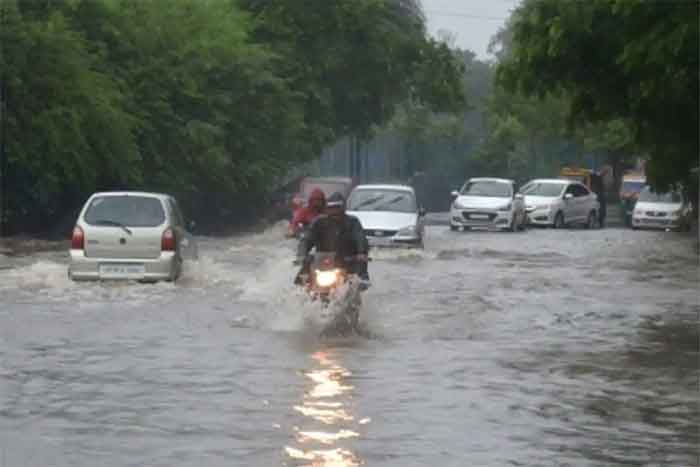In the last few years, we have been witnessing erratic, unpredictable and unexpected changes in climate, which are more perceptible in the Himalayan region of the country. These changes are threatening agriculture productivity as well as livelihood security of rural communities. If ignored, climate variability and climate change can disrupt food supply chains, reduce access to food, and affect food quality for everyone. In Uttarakhand, the impact of climate change in the agrarian sector has been quite noticeable in the last few years.
“There has been a clear shift in farming practices adapted by the hill dwellers in recent years. The persistent rise in temperatures has altered both the crop and the place for cultivation. For example, we used to do apple cultivation at an altitude of 6,000 ft in the 1980s, but it has now shifted to an altitude of 6,500 ft – 7,000 ft. Similarly, orange and apricot cultivation too has seen a shift from 4,500 ft to 6,000 ft now. This shift not only reduced the profit, but many cultivators were not able to accommodate or afford the changes. It has definitely had a bearing on our pockets,” said Sanju Kaparwan, local farmer from Joshimath town of Chamoli district in Uttarakhand.
He said, earlier the cost of investment for one crop was around Rs 5,000-6,000, which has now doubled on account of increase in costs of transportation, fertilisers, and irrigation. He also complained that the quality of fruits has also deteriorated dramatically due to rising temperatures.
 The researchers of a two- year old study titled Farmers’ Vulnerability to Climate Change: A Study in the North Himalayan Region of Uttarakhand, India assessed location-specific adaptation and mitigation strategies for farmers in the state. The study was conducted by scientists of two institutes- GB Pant University and of Agriculture and Technology and National Academy of Agriculture Research Management in Garhwal and Kumaon Division of the state . The findings indicated that the majority of the respondents (64%) were found moderately vulnerable to climate change. Good thing is that it was found , more than 90 per cent knew about adaptation practices such as adoption of drought/frost tolerant practices, change in planting time, transitioning from farming to non-farming activities and diversification of crops and varieties.
The researchers of a two- year old study titled Farmers’ Vulnerability to Climate Change: A Study in the North Himalayan Region of Uttarakhand, India assessed location-specific adaptation and mitigation strategies for farmers in the state. The study was conducted by scientists of two institutes- GB Pant University and of Agriculture and Technology and National Academy of Agriculture Research Management in Garhwal and Kumaon Division of the state . The findings indicated that the majority of the respondents (64%) were found moderately vulnerable to climate change. Good thing is that it was found , more than 90 per cent knew about adaptation practices such as adoption of drought/frost tolerant practices, change in planting time, transitioning from farming to non-farming activities and diversification of crops and varieties.
Around the same time, the Wildlife Institute of India (WII) too came up with its findings revealing that farming of 30 traditional crops was abandoned in Pithoragarh district in the last one decade due to climate change and migration.
This study titled ‘Conservation of indigenous crop varieties and vulnerability assessment of agro-ecosystem in Pithoragarh district’ reported how agricultural land use has declined to 19% in the last one decade along with an overall decline of 28% in the area of cultivation in the district.
The agriculture in the Pithoragarh district, which shares a border with Nepal and China, is mainly rain-fed just like many other hill districts of the state and is for subsistence rather than economic gains.
A few such studies have been carried out to assist policy makers in the government sector in designing and enforcing adaptation strategies to minimize the adverse impact of climate change on agriculture in the vulnerable zones .
The state has however been moving very slowly in adapting to the newer climate change resilient techniques in the agriculture sector. One glimmer of hope shone in July this year when the state government launched a new project named Climate Responsive Rain-Fed Farming Project, aided by The World Bank to the tune of Rs 1000 crore in nine districts . The officials of Watershed Department, which is to implement this project, are claiming that this new initiative will help in adapting sustainable agrarian practices, watershed management, boosting agriculture productivity, promoting cluster based agriculture and, also in containing migration of youth from villages.
DS Rawat, deputy director at Watershed management Directorate said, “Erratic rainfall is damaging the prospects of farmers under the rain-fed farming system. In order to reduce their dependence on water, we will promote less water intensive crops. The farmers will also be encouraged to diversify to horticulture, which is an environmentally friendly form of cultivation and can be a good additional source of income.”
There are independent non-profit organizations too which are also contributing to enhancing climate resilience and adaptive capacities of vulnerable farmers families.
The Tata Energy And Resources Institute (TERI) had collaborated with a local organization called Society for Himalayan Agriculture and Rural Development (SHARD) to launch such a pilot initiative in Huddu village of Rudprayag in 2018.
The farmers, especially women farmers who constitute the majority of the farming community in the village were encouraged to consolidate their land – a highly uncommon practice in the state. They cultivated potatoes between January and July. The first such crop of 7,500 kilograms generated an income of Rs 1.50 lakhs approximately for the community. The 48 households of the village who participated in the initiative earned an average of about Rs 3,600 from a minimum holding size of 200 sq m (or 1 nali), as compared to an average of Rs 700 from the wheat crop yields harvested from the same farm size in previous seasons.
Elated by the success of this experiment TERI and SHARD had also distributed large cardamom plants, an expensive spice, to some of Huddu’s households to provide them with a supplementary source of income.
“Huddu village has emerged as a shining example of how community farming can help offset the adverse impacts of climate change in the agriculture sector. Such experiments become more relevant for the places that are most vulnerable to climate change,” Suruchi Bhadwal, Climate Change expert at TERI associated with this project said.
Himalayan Action Research Centre (HARC), a farming based organization identified 17 wild fruits and nuts with good taste and medicinal properties and transformed them into high yielding edible products. This project was supported by the ministry of environment and forests, ,Uttarakhand State Council of Science and Technology and GB Pant National Institute of Science and Technology.
Mahender Singh Kunwar, secretary HARC said, “Our project provided employment to 1300 women of 62 villages of Chamoli district who have begun collecting and processing these edibles at Kaleshwar plant of HARC in Chamoli district. These products, marketed and packaged smartly, are also available online.”
He said , the need of the hour is to harness natural food resources available in the surroundings. This sort of cost effective diversification can be a boon for the farmers who are struggling to cope with the vagaries of climate change while sticking to the traditional crop pattern and farming techniques.
Seema Sharma is a Chandigarh based freelance journalist who writes about environment, climate change, human rights and gender issues . She tweets at seema_ env















































